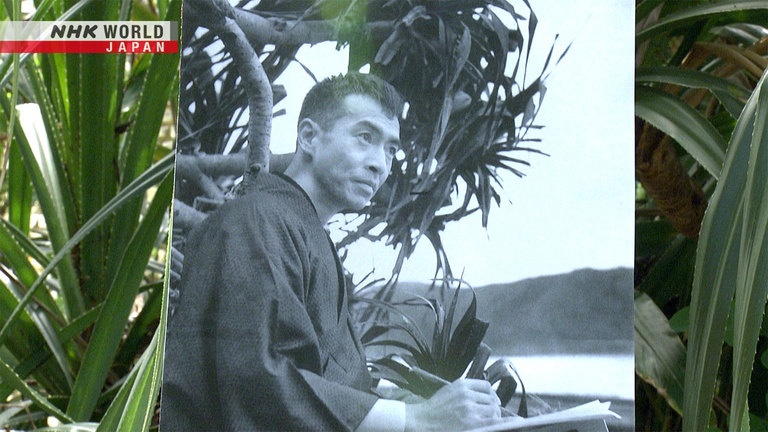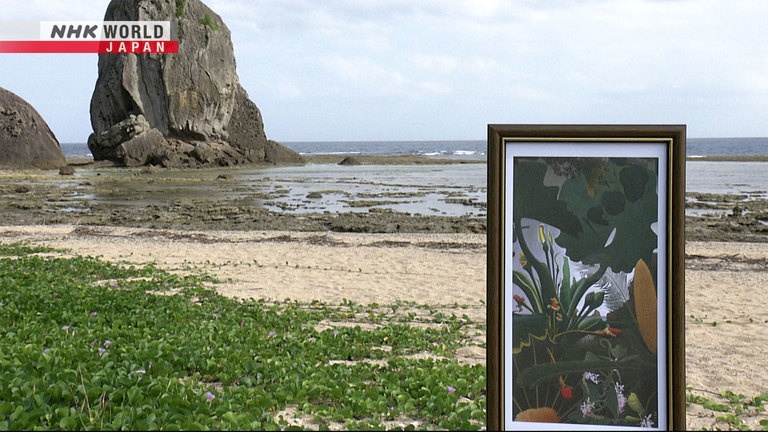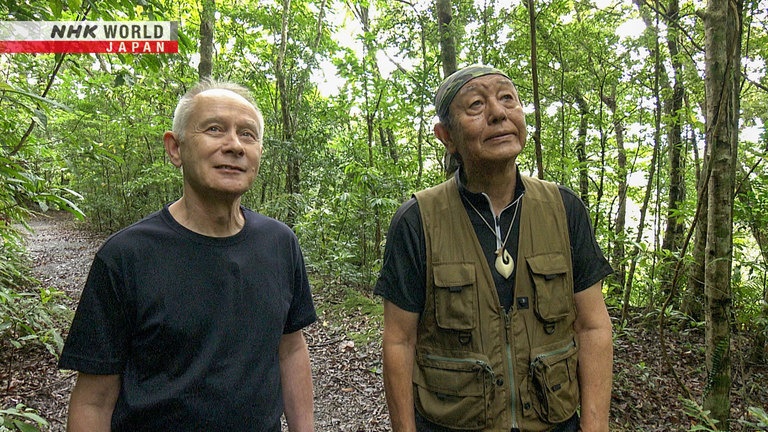Amami Oshima: Paradise Found
*First broadcast on July 6, 2023.
We explore Amami Oshima, a subtropical paradise, through the stunning art of Tanaka Isson. Sometimes referred to as "the Japanese Gauguin," Isson found new inspiration after moving to this southern island. While his work was not appreciated during his lifetime, today it is frequently featured in exhibitions around Japan. In the first of two episodes about Amami Oshima, Peter Barakan follows in Isson's footsteps, and discovers why his work has become so enduringly popular.



Transcript
Hello, and welcome to Japanology Plus.
I'm Peter Barakan.
This is the first of two programs
about Amami Oshima,
literally, “the big island of Amami,”
which is where I am now.
On this part, we'll focus on Tanaka Isson,
an artist for whose work
I have a particular fondness.
Although his talent was recognized
when he was still a child,
his work didn't receive
widespread acclaim until
after he died at the age of 69, in 1977.
Two years later, some of his neighbors
organized a small exhibition of his work,
which was what set the ball rolling.
His depictions of Amami's natural beauty
immediately struck a chord
with just about everybody that saw them,
and over the years, his art has come
to be frequently exhibited all over Japan.
Today we'll explore Amami Oshima,
and look at why Tanaka Isson's art
has remained so popular.
Amami Oshima is hundreds
of kilometers southwest
of the nearest of Japan's main islands.
It is a lush, subtropical paradise.
The forests here
showcase exotic natural beauty.
And the crystal-clear waters
are a distinctive blue.
Our first destination is situated
in the northern part of the island.
It's the Tanaka Isson Memorial Museum of Art.
At the age of 50,
Isson left his home near Tokyo
to come here,
and paint local subjects in solitude.
Wow. Black and white version of it.
A bold composition draws the eye.
But there are detailed,
delicate touches here too.
The forest scenes
have an almost mystical appeal.
Tanaka Isson's talent wasn't widely
recognized until after his death.
Because he moved to a remote island
in the south,
he is compared to the
French artist Paul Gauguin.
Now, nearly half a century
after his death,
Isson's work is held in high regard,
and exhibitions are often held
around the country.
Oh, here it is.
Wow. I've seen this
so often in photographs.
I hadn't realized it was quite this big.
Isson regarded this painting
as one of his greatest achievements.
In a letter, he described it
as the work by which he would like
to be judged in the life hereafter.
Hello.
Oh, hello. Nice to see you.
Thank you very much
for letting us come in today.
I'm the curator of the museum.
Uehara's the name.
“Alocasia and Sago Palm” is seen
as the pinnacle of Isson's career.
What do you think of it?
There's kind of hyper-reality to it,
I suppose.
I mean, the composition and the colors,
and just everything about it.
It's a bit mysterious too.
The yellow parts
at the top are alocasia flowers.
And at the bottom are its red seed pods.
In this one frame,
you can see the plant's lifecycle.
This is the male flower of the sago palm,
a typical subtropical plant.
And this is the female flower.
Both blooming at the same time.
This natural abundance conveys
a strong sense of vitality.
Isson came here at the age of 50,
and died aged 69.
That means he spent 19 years
on the island.
He painted this towards the end,
and so I think the work also reflects
his own sense of mortality,
of life and death.
Isson's decision to move
to Amami Oshima was inspired
by a failure to win acceptance
in Japan's mainstream art community.
He wanted to leave that world behind.
This subtropical scenery
was totally new to him,
and he sketched
what he saw with enthusiasm.
For an artist, the island's
many unusual plants and animals
represented a treasure trove
of subject matter.
This biodiversity later led
to the island's being registered
as a UNESCO World Natural
Heritage Site in 2021.
Kijima-san, nice to meet you.
What are we going to be doing?
Well, I'm planning to take you on a tour
of some World Heritage scenery.
OK.
Kijima Kosuke, an Amami Oshima native,
is a veteran ecotour guide.
Let's go.
It'll be a bit bumpy. Very, actually.
OK.
Alocasia.
Oh wow. The leaves really are big,
aren't they?
They are.
And there is the flower.
Do you see it?
Did you ever meet Isson?
Yes, back when I was a teenager.
He was wearing a very rough,
informal outfit.
And he looked right at me.
I still remember that piercing gaze.
But it was only much later
that I realized who he actually was.
So is this fenced off
because it's protected?
Yes. You should be accompanied
by a certified ecotour guide.
Having a guide helps visitors
avoid stepping on precious plant life.
The mountain air.
It's different, isn't it?
You can actually smell the nature
up here, can't you? It's beautiful.
Isson, too, must have been excited
to see the island's flora and fauna
for the first time.
That's the rurikakesu.
Oh, that? That's the rurikakesu?
The Lidth's jay. Oh yeah.
It's not that bad a voice!
Lidth's jay, a beautiful bird sometimes
thought to have a harsh call,
is one of many creatures endemic
to these islands.
Amami Oshima alone
has an impressive concentration
of endemic creatures,
including around 30 animals
and over 120 types of plant.
The island was once part
of the Eurasian continent,
but millions of years ago it split off.
The result was an isolated environment
in which distinctive plants
and animals emerged.
See this?
It's endemic: Calanthe amamiana.
It has pink flowers.
Oh.
Here's another: Arisaema henterocephalum,
a relative of the alocasia.
It would be easy to step on one
if you don't know where to look.
Right, if you came in here
by yourself without a guide,
you just wouldn't even probably
notice that.
That's why it's best
to travel with a guide.
See these leaves?
What's that?
The flowers of this plant grow close
to the ground.
Inside, they're like tubes.
It's very difficult for the seeds
they produce at the bottom
to be carried out by ants and so on.
As a result, few seeds are spread,
so those seeds are precious.
It's said to take a hundred years
for the Heterotropa lutchuensis
to spread a distance of just one meter.
See these?
Isson often painted them.
Mussaenda parviflora.
Those white parts are not petals,
they're sepals.
Ah, OK, yes.
I have seen those in his paintings.
Eventually they'll grow yellow,
star-shaped flowers.
What kind of plants
did Isson like to paint?
He painted what was
inside the layers of greenery.
Inside the forest.
Plants like this offered color,
within the gloom.
His paintings have bright backgrounds.
You see light green, medium green,
dark green, and very dark green.
Different shades.
In the forest, you sometimes think,
“Hang on, I saw this in a painting.”
Look again,
and you realise it's an alocasia.
It's interesting to see some
of the things that Isson painted.
You get a feel for how he himself
related to the nature here.
Before he moved to Amami Oshima,
and produced the best work of his life,
Tanaka Isson had a difficult career.
He was born in 1908,
in Tochigi Prefecture.
His talent was evident from an early age,
and it was nurtured
by his father—a sculptor.
Isson was seen as a child prodigy.
In his teens,
he became more serious about his art,
and began specializing in scenes
that made effective use of ink.
His work was highly regarded,
and attracted buyers.
At 18,
he was admitted
to Japan's top school for artists:
the Tokyo School of Fine Arts.
But after just two months,
he stopped attending.
Some say a deterioration
in his father's health
put the family in a difficult situation.
But he'd already been working
professionally for several years,
and so although he enrolled at the school,
he may have thought that there
wasn't anything he needed to learn.
That's another theory.
Isson was brimming with confidence.
At the age of 23,
he produced an ambitious new work
that he hoped would advance his career.
But that didn't happen.
It was an unassuming,
simple depiction of nature,
featuring freshwater fish, greenery,
and a striking flower.
Rather than producing something
that satisfied the expectations
of his customers,
he painted from the heart.
This was the kind of art
that he himself wanted to create.
It was a total departure
from the bold, powerful work
he had produced until that point.
Isson wrote about
how the work was received:
“I painted what I thought was right,
and showed it to people
who'd supported me.
But none of them approved,
and they all turned their backs on me.”
Crushed by this lack of recognition,
he decided to abandon
his career as an artist.
He had total belief in his technique.
His father taught him the basics
when he was still young.
Once, when his father corrected
a drawing, Isson himself ripped it up.
Ohh.
A person like that isn't content
to keep producing the kind of artwork
that everyone expects.
I think it was inevitable that he would
want to create something totally new.
After quitting art, Isson left Tokyo,
and became a farmer
in neighboring Chiba Prefecture.
He was 30 years old.
The natural world began
to reawaken his creativity,
and once again he picked
up his sketchbook.
Then came the Second World War.
It was impossible for Isson
to return to art in earnest.
But two years after the end of the war,
at the age of 39, Isson submitted
this work to a public exhibition—
and it was accepted.
It was a striking image,
featuring gleaming white flowers
on a lush green background.
16 years after giving up on art,
he had produced a new work that finally
brought him a degree of recognition.
Isson thought
that this was his big break.
The next year,
he produced this large painting.
It was a piece of work
that he was even more proud of.
One of Japan's top artists
at the time, Kawabata Ryushi,
sponsored a major art exhibition.
Obviously, Isson himself was convinced
his piece would be selected.
But unfortunately things
didn't turn out that way.
It was rejected.
Really?
So was he very disappointed about that?
Rather than disappointed, he was furious.
He remonstrated with Kawabata himself.
And that did not make
a very good impression.
Yeah, I can imagine.
Isson continued to submit work
to exhibitions,
but for 11 straight years,
he was rejected.
At the age of 50,
he made one final attempt.
Isson put everything
he had into this piece.
But this, too, was rejected.
In a fit of despair,
he gathered up almost every piece
he'd created until that point,
and burned them.
He sought a clean break.
Isson sold his house in Chiba and moved
to what was, at the time,
close to the southernmost inhabited island
in Japan.
What do you think Isson was
trying to achieve when he came to
Amami in the first place?
He was looking for something he wanted
to paint, or that only he could paint.
New motifs that only he could depict.
I think that's what he was after.
Isson had hit rock bottom.
He rented a house in a small settlement
where he could try to restore
his confidence, and find his feet again.
At the time, Japan's economy was booming.
It was a period of prosperity.
But Isson turned his back on that.
In his modest home,
he devoted himself to painting.
To save on costs,
he grew his own vegetables and lived
a mostly self-sufficient lifestyle.
If he ran out of money for art supplies,
he would reluctantly work
as a dyer at a local textile workshop.
Then, when he'd earned enough,
he would quit,
and again concentrate on his art.
Oh, and this is where...
his very last house...
At the age of 69, while cooking dinner
at home, Isson collapsed.
He died alone.
The house has been preserved
by the “Isson-kai,”
a local group that
celebrates Isson's achievements.
How did you come to start the Isson-kai?
Two years after Isson died,
some of the people who knew him
organized a posthumous exhibition,
just to display his work.
But seeing the response,
we decided to set up an art gallery.
Our goal changed.
And that was the beginning
of Isson-kai's activities.
The first-ever exhibition of Isson's art
came two years after his death.
It was incredible.
This isn't a big community,
and so we couldn't believe how many people
were coming along to see it.
Some of them came again,
bringing friends and family with them.
We had about 3,000 visitors in three days.
For people born in Amami,
these are very familiar plants.
You see them all the time, and in fact,
some of them are a nuisance for farmers!
Seeing them represented in works
of art took everyone by surprise.
But local people just loved them.
Isson saw things we didn't notice.
Through his eyes, we came
to see the island's natural beauty.
That was true not just for me
but for many people.
Amami Oshima recently
became a World Natural Heritage Site.
And I think that's partly
because Isson's work drew attention
to the beauty of the scenery here.
Even after recognition by UNESCO,
Isson is still very influential.
His paintings of flowers and trees
continue to inspire the public
to take an interest
in their island surroundings.
The paintings present everyday
island scenes.
But Isson transforms them
into captivating images.
How did he do that?
Hamada Kosaku
is a photographer and island resident.
He has dedicated his life
to conveying the hidden powers
of Amami's natural realm.
And he believes that
Isson's ability to depict
this otherworldly atmosphere
is key to his appeal.
Whoa. It looks like the one
in Isson's picture.
This is an example of a tachigami.
In “Alocasia and Sago Palm,”
the rock is shown in the distance,
beyond the greenery.
Tachigami are said to be places
where spirits alight.
The island deities reside on the other
side of the sea, beyond the horizon.
That's the location of paradise.
And during festivals,
the deities come to visit.
We give them a warm welcome,
with food, and with dancing.
Every summer,
on the coast of Amami Oshima,
a festival is held
to encourage the deities
to travel over from their home
in paradise, beyond the horizon.
People pray to the deities
for a bountiful harvest,
and for happiness in the island.
The deities find their way to their
destination with the help of a tachigami,
and so these special rocks
are cherished in the islands.
He lived here for nearly 20 years.
His art seemed to evolve and change
several times during that time,
and he was still actively painting right
up until the end.
Do you have any thoughts,
or do you imagine
what he was trying to achieve
in his painting,
in the final days of his life?
Well, in “Alocasia and Sago Palm,”
think of the composition.
We're deep in the forest, looking out.
For visitors, it's different.
For them,
they'd be on the outside looking in.
Isson was here for 19 years;
he knew the forest.
He understood the view
from that perspective.
He knew how great it looked.
The painting shows the tachigami.
But it's placed far away
in the background.
We see the changing plant life
of the island, and beyond that,
we see something that doesn't change
at all, no matter how many centuries pass.
It shows that he understood
what's important to the island people.
He was able to convey that.
And I think he was aiming
to convey something universal.
That's how I see it.
Isson presents the realm of the deities
glimpsed through
the dense forest foliage.
To Hamada, this harmonizes
with the spirit of Amami Oshima.
No matter what people
may have to go through in everyday life,
there is a world, they hope,
that will bring happiness.
Tanaka Isson worked in obscurity,
and his talent was not
appreciated during his lifetime.
But this painting
may communicate the idea that,
although life can be hard,
happiness is always waiting for us,
just beyond the horizon.
“Alocasia and Sago Palm.”
This painting represents the culmination
of Isson's art, and his life.
Its power to move is undiminished.
I first saw Isson's work
without knowing anything about him,
and I didn't know anything
about his relationship to Amami either.
But there was something in the
work itself that just drew me into it,
and that was part of the reason
why I wanted to come here.
But having seen various things relating
to Isson's work,
and come down here to the rock,
which also has a kind
of otherworldly feeling,
I feel like I've got a little closer
to the man himself,
which is a very rewarding feeling,
I must say.
Thank you.